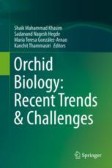Search
Search Results
-
Drakolide Structure-activity Relationships for Sexual Attraction of Zeleboria Wasp Pollinator
Orchids pollinated by sexual deception lure their specific male pollinators by sex pheromone mimicry. Despite the growing list of chemically diverse...

-
Lack of Female Preference for Nuptial Gifts May Have Led to Loss of the Male Sexual Trait
Evolutionary loss of sexual traits may occur if the forces that maintain those traits weaken or disappear. Females may evolve resistance or a change...

-
Museum records indicate male bias in pollinators of sexually deceptive orchids
Deception has evolved in a range of taxa. When deception imposes costs, yet persists over generations, exploited species typically have traits to...

-
Are some species ‘robust’ to exploitation? Explaining persistence in deceptive relationships
Animals and plants trick others in an extraordinary diversity of ways to gain fitness benefits. Mimicry and deception can, for example, lure prey,...

-
Honesty in signalling games is maintained by trade-offs rather than costs
BackgroundSignal reliability poses a central problem for explaining the evolution of communication. According to Zahavi’s Handicap Principle, signals...

-
Does the orchid Luisia teres attract its male chafer pollinators (Scarabaeidae: Protaetia pryeri pryeri) by sexual deception?
The epiphytic orchid Luisia teres (Asparagales: Orchidaceae) releases floral scent that attracts males of the cupreous polished chafer Protaetia...

-
Stressful environments favor deceptive alternative mating tactics to become dominant
BackgroundDeceptive alternative mating tactics are commonly maintained at low frequencies within populations because males using them are less...

-
Comparative morphology of Southern Ocean Euphausia species: ecological significance of sexual dimorphic features
Species of the genus Euphausia dominate the euphausiid biomass of the Southern Ocean, the three largest being Euphausia superba , E. triacantha and E....

-
Improving conservation and translocation success of an endangered orchid, Caladenia xanthochila (Orchidaceae), through understanding pollination
Critical for conserving endangered orchids is identifying their pollinators and their distribution. Caladenia xanthochila is an endangered orchid...

-
The ‘Mimic’ or ‘Mimetic’ Octopus? A Cognitive-Semiotic Study of Mimicry and Deception in Thaumoctopus Mimicus
This study discusses the mimic octopus’ ( Thaumoctopus mimicus ) acts of imitation of a banded sea-snake ( Laticauda sp.) as an antagonistic response to...

-
Evolution of reduced mate harming tendency of males in Drosophila melanogaster populations selected for faster life history
AbstractDetrimental effect of males on female, often termed mate harm, is a hallmark of sexual conflict. Allowed to evolve unchecked, mate harming...

-
How do rewardless Bletilla striata flowers attract pollinators to achieve pollination?
Rewardless plants use various strategies to attract pollinators. Generalized food-deceptive species exploit the nonspecific food-seeking responses of...

-
The orchid mantis exhibits high ontogenetic colouration variety and intersexual life history differences
Masquerade, the resemblance of animals to inedible or inanimate objects, exists universally throughout the animal kingdom, especially in arthropods....

-
Two closely related species of the Arisaema ovale group (Araceae) selectively attract male fungus gnats of different Anatella species (Diptera: Mycetophilidae)
Arisaema sect. Pistillata (Araceae) is a rapidly diversifying taxon in the Japanese archipelago. Several sympatric Arisaema species selectively...

-
Beauty of Orchid Flowers Are Not Adequate to Lure Indian Biologists
Orchids are always receiving a special attention among biologists globally, owing to their stunning colours, peculiar shapes, unique floral...
-
Deceived, but not betrayed: static allometry suggests female ornaments in the long-tailed dance fly (Rhamphomyia longicauda) exaggerate condition to males
Despite their prevalence in nature, the evolution of sex-specific female ornaments is still not well understood. Although in some cases (often...

-
Science fosters ongoing reassessments of plant capabilities
It is suggestive that some plant features, like the absence of specialized sensory organs to detect various environmental stimuli and their sessile...

-
Evolution of Organismal Female Wasp Mimics in Sexually Deceptive Orchid Genus Chiloglottis (Orchidaceae)
Orchids are fascinating to the evolutionary biologists because of their spectacular flower structure, colours and specialized strategies in...
-
The Mating Machine
Gene transmission and hence fitness, for any animal, is a direct product of sex. Offspring production is the essential currency rewarded by natural...
